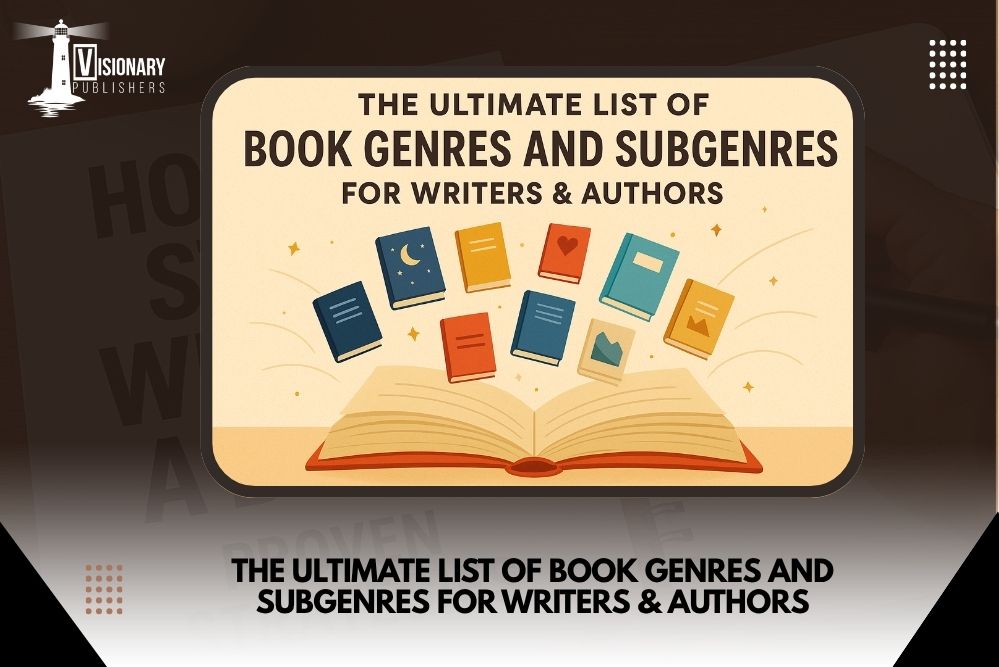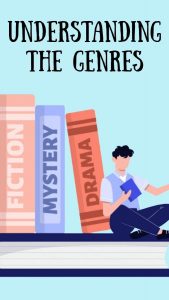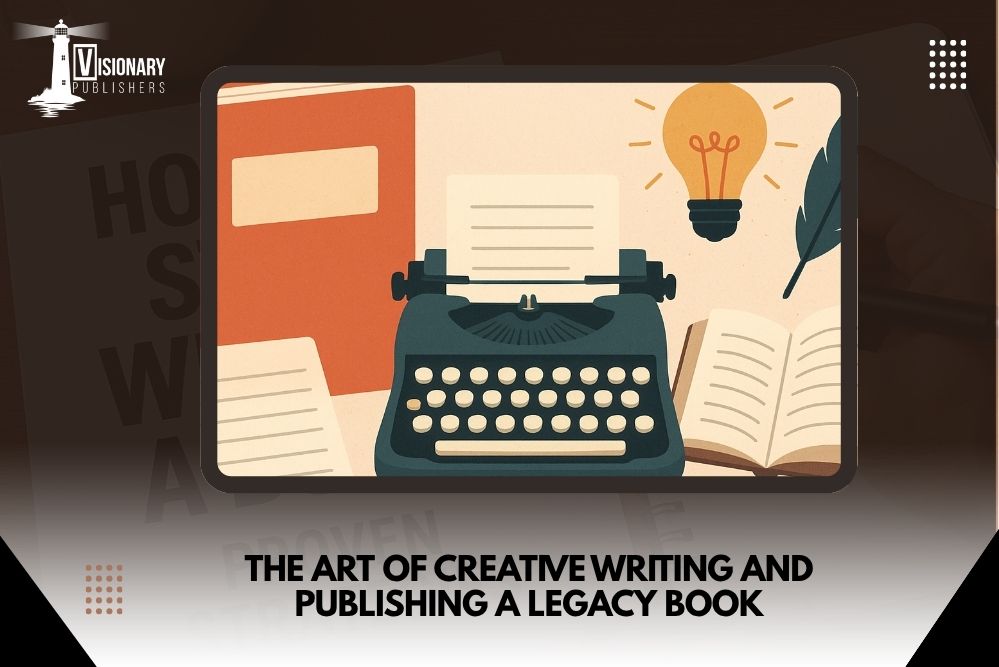Intro
When you sit down to write your next book, one of the first questions you’ll ask is: what genre should I write in? Choosing the right genre is more than just picking a label. It guides your story, your characters, and even how readers discover your work.
The list of book genres and subgenres is vast, from romance to thriller, sci-fi to memoir. Understanding the different types of book genres helps you connect with your audience and craft a story that resonates.
In this guide, we’ll explore the most popular book genres, explain their subgenres, and give examples that can inspire your next title. Whether you’re a first-time author or a seasoned writer, knowing your options will help you make smarter creative and marketing choices. Let’s dive into the world of book genres and discover how to align your story with the perfect audience.

What Are Book Genres and Subgenres?
Book genres are categories that group stories with similar themes, settings, or tones. Subgenres break these larger categories into more specific types, helping readers find exactly what they want.
For example, fantasy is a popular book genre, but it includes subgenres like urban fantasy, high fantasy, and dark fantasy. Romance has subgenres like contemporary romance, historical romance, and paranormal romance. Understanding both genres and subgenres allows writers to craft stories that target the right audience and stay true to reader expectations.
Top 10 Most Popular Book Genres Explained
Fiction
Fiction is all about stories created from imagination. It can reflect real-life situations or explore completely fantastical worlds. Literary fiction emphasizes deep characters, themes, and book writing style, while historical fiction blends imaginative storytelling with actual historical events. Contemporary fiction reflects modern life and society. Writers in fiction focus on creating believable characters, engaging plots
Immersive settings.
Fiction allows authors to explore human emotions, social issues, and moral dilemmas in ways that resonate with readers.
Romance
Romance books focus on love stories and emotional connections. Subgenres include contemporary romance, which deals with modern relationships; historical romance, set in past eras; paranormal romance, which includes supernatural elements like vampires or witches; and romantic suspense, which blends love with thrilling action. Romance is consistently one of the highest-selling book genres because readers enjoy stories about relationships, emotional growth, and personal connections. Romance novels often emphasize character chemistry, emotional arcs, and satisfying endings.
Mystery and Thriller
Mystery and thriller books are designed to keep readers guessing. Mystery stories involve solving crimes, uncovering secrets, or piecing together puzzles. Thrillers prioritize suspense, tension, and unexpected twists. Subgenres include cozy mysteries, which are lighter and often set in small towns; psychological thrillers, which explore the human mind and motives; and crime fiction, focusing on criminal investigations. These genres engage readers by creating suspense, challenging them to solve the puzzle, and delivering gripping narratives.
Science Fiction and Fantasy
Science fiction (sci-fi) and fantasy transport readers to other worlds or future realities. Sci-fi often deals with futuristic technology, space exploration, or dystopian societies, with subgenres like space opera or cyberpunk. Fantasy immerses readers in magical worlds with mythical creatures, epic quests, and imaginative landscapes, including urban fantasy and dark fantasy. These genres allow writers to explore complex themes such as morality, society, or human nature while crafting worlds that stretch the imagination.
Young Adult (YA)
YA fiction is written for teenagers but often attracts adult readers as well. These books explore themes like identity, love, friendship, and personal growth. Subgenres include contemporary YA, which addresses real-life teen issues; fantasy YA, which includes magical or supernatural elements; dystopian YA, which portrays societies in crisis; and YA romance. YA books are known for their fast-paced narratives, relatable characters, and coming-of-age stories, helping young readers navigate life lessons through engaging storytelling.
Historical Fiction
Historical fiction blends real historical events with fictional characters or plots. Subgenres include historical romance, which tells love stories in historical settings; historical thrillers, which combine suspense with history; and historical mysteries, which explore crimes in past eras. Writers must research historical facts to make their stories accurate while using creative freedom to develop plots and characters. This genre appeals to readers who love learning about history through immersive, entertaining stories.
Non-Fiction
Non-fiction tells real stories or provides factual information. Popular types include memoirs, which recount personal experiences; biographies, which focus on other people’s lives; self-help books, which guide readers toward personal improvement; and how-to guides, which provide practical instructions. Non-fiction allows writers to share knowledge, expertise, or personal insights, helping readers learn, grow, or be inspired. Accuracy, clarity, and credibility are essential in non-fiction writing.
Horror
Horror books aim to frighten, unsettle, or shock readers. Subgenres include gothic horror, which often has dark, eerie settings; paranormal horror, featuring supernatural beings or events; and psychological horror, exploring fear, suspense, and the human mind. Horror relies on atmosphere, tension, and pacing to create emotional impact. Writers in this genre focus on eliciting fear while exploring themes like mortality, morality, or the unknown.
Children’s Literature
Children’s literature is written for young readers and includes picture books, early readers, and middle-grade novels. These books often combine entertainment with lessons about life, friendship, morals, or problem-solving. Authors use simple language, colorful book illustrations, and relatable characters to engage kids. Subgenres include fantasy for kids, adventure stories, and educational books. The goal is to spark imagination, build reading skills, and provide meaningful entertainment for children.
Poetry and Drama
Poetry focuses on expression through concise, rhythmic, or metaphorical language, exploring emotions, ideas, or imagery. Drama, on the other hand, is written for performance on stage, often structured as plays or scripts. Both genres allow authors to experiment with language, tone, and structure in ways other genres may not. Writers explore emotion, human conflict, and storytelling through unique stylistic choices, appealing to readers or audiences who appreciate creative expression.

Why Understanding Book Genres Helps Writers
Knowing your genre and subgenre is crucial for crafting a focused story. It helps guide tone, plot, and character development. It also helps with marketing. Readers often search for specific types of books, so using the correct genre ensures your book reaches its ideal audience. A well-classified book also attracts publishers and agents looking for stories that fit their niche.
Title and Subtitle Ideas Based on Genres
The title of your book is often the first thing readers notice. A strong title immediately communicates your genre, sparks curiosity, and makes your book memorable. Pairing it with a well-written subtitle adds clarity, conveys the book’s purpose, or gives readers a taste of the story or theme. Below, we explore examples for different genres and how authors can craft compelling titles.
Mystery and Thriller
For mystery and thriller books, titles should evoke suspense, intrigue, or danger. Subtitles can clarify the type of mystery or series.
- The Silent Witness: A Detective Harper Novel — This title signals a crime or investigation story, while the subtitle establishes a recurring character and series potential.
- Murder on Maple Street: A Cozy Mystery — Highlights the crime, setting, and cozy tone for readers who prefer lighter mysteries.
Romance
Romance titles often hint at emotion, relationships, or love conflicts. Subtitles can emphasize the story’s type or tone.
- Love in the Rain: A Heartwarming Contemporary Romance — Conveys a sweet, modern love story.
- Forbidden Hearts: A Historical Romance — Implies tension and romance set in a past era.
Science Fiction and Fantasy
Sci-fi and fantasy titles should reflect imagination, adventure, or otherworldly settings. Subtitles can clarify scope or series placement.
- Starlight Odyssey: Adventures Beyond the Galaxy — Suggests epic space adventure.
- The Dragon’s Pact: A Dark Fantasy Tale — Evokes magic, danger, and mythical creatures.
Non-Fiction
Non-fiction titles need to be informative and actionable, while subtitles often describe benefits or results.
- The Productivity Blueprint: Habits for Success in Work and Life — Clearly communicates the value for readers seeking personal growth.
- Mastering Social Media: Strategies for Small Business Growth — Offers actionable guidance with clarity.
Tips for Choosing Effective Titles and Subtitles
A strong title and subtitle can make your book stand out on crowded shelves or in online marketplaces. A great title grabs attention, hints at the story or content, and leaves readers curious to explore more. Here are practical tips to create titles and subtitles that truly engage readers:
-
Keep It Short and Memorable
A title should be easy to remember and quick to read. Long or complicated titles can confuse readers or be hard to recall. Focus on a few impactful words that capture your book’s essence. For example, The Silent Witness immediately conveys mystery and suspense.
-
Use the Subtitle to Explain or Add Context
The subtitle provides clarity and tells readers what to expect. It highlights the promise of the book or its main benefit. For instance, A Heartwarming Contemporary Romance clearly communicates genre and tone, helping the right audience connect instantly.
-
Include Keywords for Visibility
Adding relevant keywords improves discoverability online. Words related to your genre, topic, or theme help potential readers find your book in searches, boosting its reach and visibility.
-
Test Titles With Real Readers
Share title ideas with beta readers, friends, or your target audience. Their feedback helps you see if the title sparks interest, is memorable, and accurately represents the book.
-
Think Beyond Marketing
A title and subtitle define your book’s identity. They set reader expectations and can turn casual browsers into eager readers. A clear and appealing combination increases engagement and creates lasting impact.
By following these tips, authors can create titles and subtitles that capture attention, convey meaning, and draw readers in effectively.
How Visionary Publishers Can Help You Choose the Right Genre
Choosing the right genre is one of the most important steps for any author. At Visionary Publishers, we take the stress out of this process and guide you every step of the way. Our team helps you identify the perfect genre and subgenre for your story, ensuring it resonates with your target readers. We analyze market trends, advise on writing style, and provide expert insights into what readers expect in your chosen genre. But our support doesn’t stop there. Once your genre is set, Visionary Publishers can help you bring your book to life. We offer professional ghostwriting and editing services to ensure your manuscript is polished and compelling. Our skilled design team creates eye-catching book covers and interior layouts tailored to your genre, helping your book stand out in a crowded market.
We also handle the publishing process, whether you prefer traditional or self-publishing. And to ensure your book reaches the right audience, our marketing experts craft strategies to increase visibility, drive sales, and build your author brand.
With Visionary Publishers, you can skip the hassle of navigating the publishing world alone. From choosing the right genre to writing, designing, publishing, and marketing your book, we provide a complete, stress-free solution for authors ready to make their mark.
End Notes – Mastering Genres for Better Storytelling
Choosing the right genre is essential for both storytelling and book marketing success. This ultimate list of book genres and subgenres provides a roadmap to help writers make informed decisions, write compelling stories, and reach their ideal audience. With the support of Visionary Publishers, authors can confidently navigate the world of book genres, publish effectively, and see their stories find the readers they deserve.
Frequently Asked Questions
-
What are the 14 main literary genres?
They include fiction, non-fiction, romance, mystery, thriller, fantasy, science fiction, historical, biography, memoir, horror, poetry, drama, and children’s literature.
-
How many genres are there in books?
While there are several main genres, countless subgenres exist, giving writers many options to categorize their work.
-
Where is the subtitle in a book?
The subtitle usually appears below the main title and provides additional context or highlights the theme of the book.
-
What is the difference between a genre and a subgenre?
A genre is a broad category, like romance or mystery. A subgenre is a more specific category, like historical romance or cozy mystery.
-
What genre has the most subgenres?
Fiction genres like romance, fantasy, and mystery typically have the largest number of subgenres due to their flexibility and popularity.






